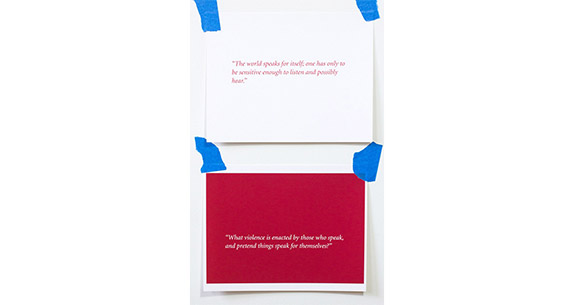Tue, May 31st and Wednesday, June 1st , 2pm–5pm | closed
Source – (Filter) – Output
Proceeding from a number of case studies, Source – (filter) – Output is a two-day seminar addressing the varied relationships creative practitioners may assume towards their source material. Delving in between the clear divides of language and event, reading and writing, analysis and creation, we will try to touch on some of the implications of creative output and the role of the subject behind or contiguous to it. Through readings, viewings, and discussions, we will consider the sensual, cognitive, and technological filters artists may apply towards their source material, the type of systems and structures they may evoke to support their generation of forms and content, and how these processes and choices may, in turn, serve as the basis for the renunciation or assumption of authorship.
Readings for Day 1:
– Weizman, Eyal (2015) The Conflict Shoreline, Gottingen: Steidl
– Bahrani, Zainab (2003) Being in the Word: Of Grammatology and Mantic. The Graven Image (pp. 96-120). Philadelphia: University of Pennsylvania Press.
– Ayache, Elie (2010) Writer of The BLANK Swan. The Blank Swan (pp. 3-29). West Sussex: Wiley.
Readings for Day 2:
– Silverman, Kaja (2009) Photography by Other Means. Flesh of My Flesh (pp. 168-221). Stanford: Stanford University Press.
– Bergson, Henri (1991) Of the Survival of Images. Memory and Mind. Matter and Memory (pp.133-177). New York: Zone Books.
– “On Using “I” and First Person Narration: Moyra Davey with Iman Issa.” Makhzin 23 April 2016: Online
Some Notes:
“I paint with my back to the world. I have a vacant mind in order to do what the inspiration calls for. And I don't start to paint until after I have an inspiration, and after I have it I make up my mind that I'm not going to interfere, not going to have any ideas."
“Stories tell themselves. They don’t get told. Don’t try to impose yourself. Wait for the story to come and speak for itself. Wait and hope that it isn’t born deaf and dumb and blind.”
“The secret is the strictly unreflected upon form of truth. It never reaches a consciousness or vanishes when it does.”
“Some say numbers are not constructed by us, but are already there waiting for us to find our way to them. Counting rules might enable me to plod successfully from 1 to N, naming each number as I reach it, but who is to say that the button waiting for me to the immediate right of the button named N is indeed the button named N+1. In Funes the Memorious, Jorge Luis Borges writes about a man who constructs a counting that is not a system of counting, a counting that makes no assumptions about what comes next after N.”
The seminar with Iman Issa is part of HWP 2015-16: From The Miraculous to the Mundane.
Iman Issa (born 1979, Cairo) is an artist based in Cairo and New York. Recent group and solo exhibitions include MACBA, Barcelona, Perez Museum, Miami, the 12th Sharjah biennial, the 8th Berlin Biennial, MuHKA, Antwerp, Tensta Konsthall, Spånga, New Museum, New York, and KW Institute of Contemporary Art, Berlin. Books include Common Elements published by the Glasgow Sculpture Studios and Thirty-three Stories about Reasonable Characters in Familiar Places published by the SculptureCenter in 2011. Awards include the HNF-MACBA Award (2012) and the Abraaj Group Art Prize (2013). Issa teaches at the Cooper Union School of Art.









